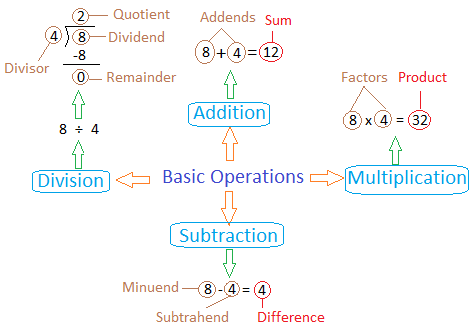Back to: MATHEMATICS JSS1
Welcome to class!
In today’s class, we will be talking more about basic operations. Enjoy the class!
BASIC OPERATIONS

Addition and subtraction of positive and negative integers using number line and collection of terms. The everyday application of positive and negative integers solving problems on quantitative reasoning in basic operation.
Numbers Can be positive or negative
This is the Number line:
| Negative Numbers (−) | Positive Numbers (+) |
| “−” is the negative sign. | “+” is the positive sign |
If a number has no sign it usually means that it is a positive number. No Sign Means Positive
Example: 5 is really +5
Balloons and Weights
Let us think about numbers as balloons (positive) and weights (negative):
This basket has balloons and weights tied to it:
|
Adding a positive number:
Adding positive numbers is just a simple addition.
| We can add balloons (we are adding positive value) the basket gets pulled upwards (positive) |
Example: 2 + 3 = 5 is really saying “Positive 2 plus Positive 3 equals Positive 5”
We could write it as (+2) + (+3) = (+5)
Subtracting a positive number:
Subtracting positive numbers is just simple subtraction.
| We can take away balloons (we are subtracting positive value) the basket gets pulled downwards (negative) |
Example: 6 − 3 = 3 is really saying “Positive 6 minus Positive 3 equals Positive 3”
We could write it as (+6) − (+3) = (+3)
Adding a negative number:
Now let’s see what adding and subtracting negative numbers looks like:
| We can add weights (we are adding negative values) the basket gets pulled downwards (negative) |
Example: 6 + (−3) = 3 is really saying “Positive 6 plus Negative 3 equals Positive 3”
We could write it as (+6) + (−3) = (+3)
The last two examples showed us that taking away balloons (subtracting a positive) or adding weights (adding a negative) both make the basket go down.
So, these have the same result:
- (+6) − (+3) = (+3)
- (+6) + (−3) = (+3)
In other words, subtracting a positive is the same as adding a negative.
Subtracting a negative number:
| Lastly, we can take away weights (we are subtracting negative values) the basket gets pulled upwards (positive) |
Example: What is 6 − (−3)?
6−(−3) = 6 + 3 = 9
Yes indeed! Subtracting a negative is the same as adding!
Two Negatives Make a Positive
What Did We Find? Adding a positive number is a simple addition …
Adding a Positive is Addition
Positive and Negative Together …
Subtracting a Positive or Adding a Negative is Subtraction
Example: What is 6 − (+3)?
6−(+3) = 6 − 3 = 3
Example: What is 5 + (−7)?
5+(−7) = 5 − 7 = −2
Subtracting a negative …
Subtracting a negative is the same as Adding
Example: What is 14 − (−4)?
14−(−4) = 14 + 4 = 18
The Rules:
It can all be put into two rules:
| Rule | Example | ||||
| +(+) | Two like signs become a positive sign | 3+(+2) = 3 + 2 = 5 | |||
| −(−) | 6−(−3) = 6 + 3 = 9 | ||||
| +(−) | Two, unlike signs, become a negative sign | 7+(−2) = 7 − 2 = 5 | |||
| −(+) | 8−(+2) = 8 − 2 = 6 | ||||
In our next class, we will be talking about the Algebraic Process. We hope you enjoyed the class.
Should you have any further question, feel free to ask in the comment section below and trust us to respond as soon as possible.
